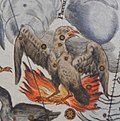Wikipedia:Today's featured article/requests/Phoenix (constellation)
Phoenix (constellation)[edit]
This nomination predates the introduction in April 2014 of article-specific subpages for nominations and has been created from the edit history of Wikipedia:Today's featured article/requests.
- This is the archived discussion of the TFAR nomination for the article below. Subsequent comments should be made on the appropriate discussion page (such as Wikipedia talk:Today's featured article/requests). Please do not modify this page.
The result was: scheduled for Wikipedia:Today's featured article/January 1, 2014 by BencherliteTalk 23:14, 19 December 2013 (UTC)
Phoenix is a constellation in the southern sky, stretches from roughly −39° to −57° declination, and from 23.5h to 2.5h of right ascension. Named after the mythical phoenix, it was first depicted on a celestial atlas by Johann Bayer in his 1603 Uranometria. The French explorer and astronomer Nicolas Louis de Lacaille charted the brighter stars and gave their Bayer designations in 1756. The brightest star, Alpha Phoenicis, or Ankaa, is an orange giant of apparent magnitude 2.4. Nu Phoenicis has a dust disk, while the constellation boasts ten star systems with planets, and HE0107-5240, possibly one of the oldest stars yet discovered. It has around 1/200,000 the metallicity that the Sun has and hence must have formed very early in the history of the universe. The recently discovered galaxy clusters El Gordo and the Phoenix Cluster—located 7.2 and 5.7 billion light years away respectively, are two of the largest objects in the visible universe. Phoenix is the radiant of two annual meteor showers: the Phoenicids in December, and the July Phoenicids. (Full article...)
- This is best visible in November, so just "past it" ...still no constellations on mainpage for a wee while......Cas Liber (talk · contribs) 14:03, 16 December 2013 (UTC)
- Support - fine article, interesting and legitimate subject matter; it's great to expose folks to some of the lesser-known constellations. – Juliancolton | Talk 16:07, 16 December 2013 (UTC)
- Comment - Look forward to supporting. The blurb is only 808 characters (with spaces) and needs to be expanded.--ColonelHenry (talk) 18:13, 16 December 2013 (UTC)
- First time I've ever had to expand one of these....did a little. How big do you want it? Cas Liber (talk · contribs) 13:23, 17 December 2013 (UTC)
- You're at 865 characters (including spaces) of displayed text; the target is 1,200 max. Don't worry about using stuff to pad it out that's not in the lead, that's fine. In practice I tend not to worry too much if it's between 1,100 and 1,200 - if it's shorter, the "right hand side" of the main page (ITN and OTD) has to be cut back to balance. BencherliteTalk 14:10, 17 December 2013 (UTC)
- First time I've ever had to expand one of these....did a little. How big do you want it? Cas Liber (talk · contribs) 13:23, 17 December 2013 (UTC)

